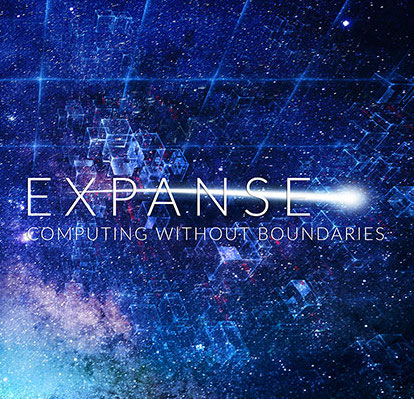The San Diego Supercomputer Center (SDSC) at the University of California San Diego, has been awarded a five-year grant from the National Science Foundation (NSF) valued at $10 million to deploy Expanse, a new supercomputer designed to advance research that is increasingly dependent upon heterogeneous and distributed resources.
The name of our new system says it all,” said SDSC Director Michael Norman, the Principal Investigator (PI) for Expanse, and a computational astrophysicist. “As a standalone system, Expanse represents a substantial increase in the performance and throughput compared to our highly successful, NSF-funded Comet supercomputer. But with innovations in cloud integration and composable systems, as well as continued support for science gateways and distributed computing via the Open Science Grid, Expanse will allow researchers to push the boundaries of computing and answer questions previously not possible.”
The NSF award, which runs from October 1, 2020 to September 30, 2025, is valued at $10 million for acquisition and deployment of Expanse. An additional award will be made in the coming months to support Expanse operations and user support.
Like SDSC’s Comet supercomputer, which is slated to remain in operation through March 2021, Expanse will continue to serve what is referred to as the ‘long tail’ of science. Virtually every discipline, from multi-messenger astronomy, genomics, and the social sciences, as well as more traditional ones such as earth sciences and biology, depend upon these medium-scale, innovative systems for much of their productive computing.
Comet’s focus on reliability, throughput, and usability has made it one of the most successful resources for the national community, supporting tens-of-thousands of users across all domains,” said SDSC Deputy Director Shawn Strande, a co-PI and project manager for the new program. “So we took an evolutionary approach with Expanse, assessing community needs, then working with our vendor partners including Dell, Intel, NVIDIA, Mellanox, and Aeon, to design an even better system.”
Projected to have a peak speed of 5 Petaflop/s, Expanse will about double the performance of Comet with Intel’s next-generation processors and NVIDIA’s GPUs. Expanse will increase throughput of real-world workloads by a factor of at least 1.3 for both CPU and GPU applications relative to Comet, while supporting an even larger and more diverse research community. Expanse’s accelerated compute nodes will provide a much-needed GPU capability to the user community, serving both well-established applications in areas such as molecular dynamics as well as rapidly growing demand for resources to support machine learning and artificial intelligence. A low-latency interconnect based on Mellanox High Data Rate (HDR) InfiniBand will support a fabric topology optimized for jobs of one to a few thousand cores that require medium-scale parallelism.
Expanse will support the growing diversity in computational and data-intensive workloads with a rich storage environment that includes 12PB of high-performance Lustre, 7PB of object storage, and more than 800TB of NVMe solid state storage.
While Expanse will easily support traditional batch-scheduled HPC applications, breakthrough research is increasingly dependent upon carrying out complex workflows that may include near real-time remote sensor data ingestion and big data analysis, interactive data exploration and visualization as well as large-scale computation,” said SDSC Chief Data Science Officer Ilkay Altintas, an Expanse co-PI and the director of SDSC’s Workflows for Data Science (WorDS) Center of Excellence. “One of the key innovations in Expanse is its ability to support so-called composable systems at the continuum of computing with dynamic capabilities. Using tools such as Kubernetes, and workflow software we have developed over the years for projects including the NSF-funded WIFIRE and CHASE-CI programs, Expanse will extend the boundaries of what is possible by integration with the broader computational and data ecosystem.”
Increasingly, this ecosystem includes public cloud resources. Expanse will feature direct scheduler-integration with the major cloud providers, leveraging high-speed networks to ease data movement to/from the cloud, and opening up new modes of computing made possible by the combination of Expanse’s powerful HPC capabilities and ubiquity of cloud resources and software.
Like Comet, Expanse will be a key resource within the NSF’s Extreme Science and Engineering Discovery Environment (XSEDE), which comprises the most advanced collection of integrated digital resources and services in the world. More details about the program will be available at the SDSC display at the SC19 in Denver.
The capabilities and services these awards will enable the research community to explore new computing models and paradigms,” said Manish Parashar, Office Director of NSF’s Office of Advanced Cyberinfrastructure, which funded this award. “These awards complement NSF’s long-standing investment in advanced computational infrastructure, providing much-needed support for the full range of innovative computational- and data-intensive research being conducted across all of science and engineering.”





